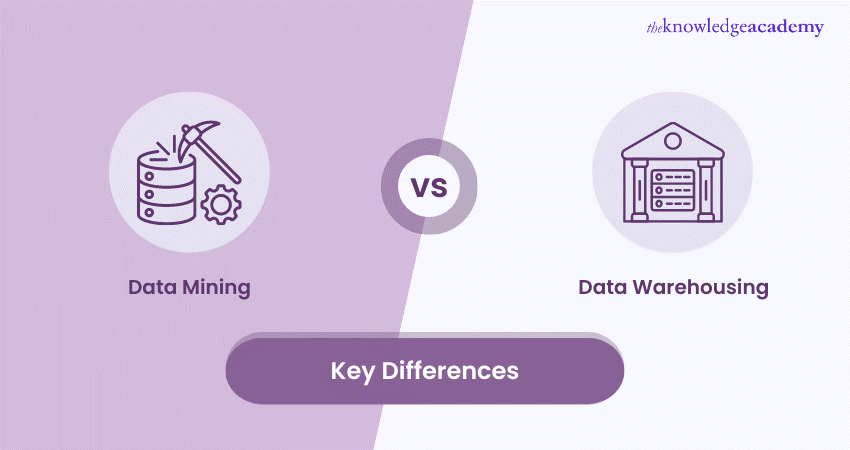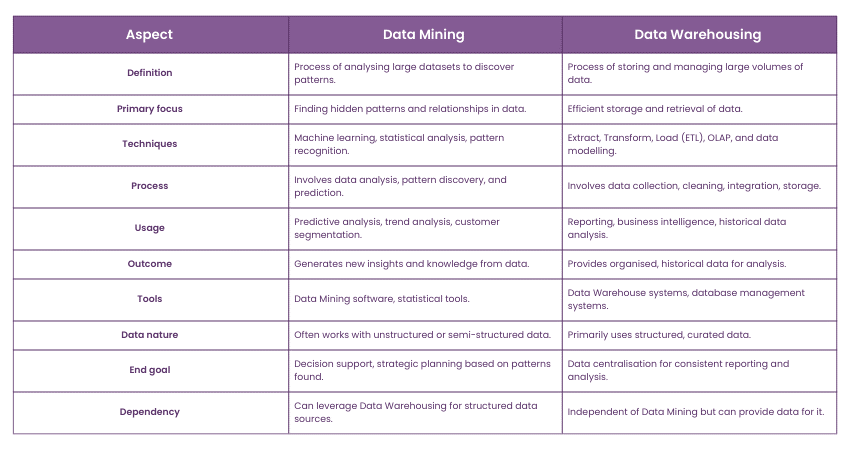We may not have the course you’re looking for. If you enquire or give us a call on 01344203999 and speak to our training experts, we may still be able to help with your training requirements.
Training Outcomes Within Your Budget!
We ensure quality, budget-alignment, and timely delivery by our expert instructors.

Data Mining is analysing large data sets to discover hidden patterns, correlations, and insights, often using advanced algorithms and statistical methods. In contrast, Data Warehousing refers to storing, consolidating, and managing large volumes of data from various sources. Understanding the differences between Data Mining and Data Warehousing will help you leverage data effectively for competitive advantage. Read this blog further to explore their unique roles, methodologies and contributions.
Table of Contents
1) What is Data Mining?
2) Benefits of Data Mining
3) What is Data Warehousing?
4) Benefits of Data Warehousing
5) Difference Between Data Mining and Data Warehousing
6) Conclusion
What is Data Mining?
Data Mining is the analytical process of exploring and analysing large datasets to discover meaningful patterns, correlations, and insights. It involves using sophisticated algorithms, machine learning, statistical methods, and Artificial Intelligence to sift through vast amounts of data to identify new trends, patterns, and relationships that might not be immediately relevant.
Data Mining aims to extract valuable information from data, enabling businesses and organisations to make informed decisions, predict trends, and improve operational efficiency. It is widely used in various fields, such as marketing, finance, healthcare, and more, to enhance decision-making and gain a competitive advantage.
Benefits of Data Mining
Data Mining offers numerous benefits across various industries by extracting valuable insights from large datasets. Here are some key advantages:
a) Improved decision-making: By uncovering hidden patterns and relationships in data, businesses can make more informed and strategic decisions.
b) Market trend analysis: Data Mining helps identify market trends, consumer preferences, and demographic patterns, enabling businesses to tailor their strategies accordingly.
c) Customer relationship management: It assists in understanding customer behaviours and needs, leading to better customer service and personalised marketing strategies.
d) Risk management: Identifies potential risks and fraudulent activities by analysing anomalies and patterns, thus aiding in proactive risk management strategies.
e) Increased efficiency: Automates finding correlations and patterns in large datasets, increasing operational efficiency.
What is Data Warehousing?
Data Warehousing is the complete process of collecting, storing, and managing vast volumes of data from various sources in a central repository. It is designed to facilitate data consolidation, analysis, and reporting to support decision-making processes. A Data Warehouse is structured to enable efficient querying and analysis, often using a special schema like star, snowflake, or galaxy for organisation.
It integrates data from multiple heterogeneous sources – such as databases, spreadsheets, and applications – and presents it uniformly. This setup allows businesses to conduct comprehensive data analysis, generate reports, and gain insights across different departments and systems.
Do you want to learn more about Data Warehouses? Register now for our Data Warehousing Training!
Benefits of Data Warehousing
Data Warehousing provides numerous benefits to organisations by enabling efficient data management and analytics. Here are the key advantages:
a) Centralised data storage: Consolidates data from multiple sources into a single repository, simplifying data management and access.
b) Improved data quality and consistency: Ensures data is cleaned, standardised, and consistent across the organisation, leading to more accurate analytics.
c) Enhanced business intelligence: Provides a comprehensive view of the business by integrating data from various sources, allowing for better strategic decision-making.
d) Efficient data retrieval: Optimised for fast query performance, enabling quick retrieval of large volumes of data for analysis.
e) Historical data analysis: Stores large amounts of historical data, making it easier to analyse trends.
Difference Between Data Mining and Data Warehousing
Since you now have a brief idea about Data Mining and Data Warehousing, let us now see the differences between them:

1) Description
Data Mining can be defined as the process of analysing large datasets to discover patterns, correlations, and trends using statistical and Machine Learning techniques. It focuses on extracting meaningful information from data. In contrast, Data Warehousing involves storing, consolidating, and managing data from various sources in a centralised repository. It's designed to facilitate the efficient retrieval and analysis of data.
2) Procedure
Data Mining involves data cleaning, integration, selection, transformation, mining, pattern evaluation, and presentation of findings. On the other hand, Data Warehousing includes data extraction from various sources, cleaning, transformation, and loading data into the warehouse (ETL), followed by data retrieval and management.
3) Objectives
The primary objective of Data Mining is to find hidden patterns and knowledge from large datasets. On the other hand, Data Warehousing aims to provide a unified, consistent data store for reporting and analysing historical data.
4) Oversight entities
a) Data Mining: Data scientists, statisticians, and analysts who focus on analysing data for insights.
On the contrary,
b) Data Warehousing: Database administrators and IT professionals who manage and maintain the data repository.
5) Data management
Data Mining manages the processes involved in mining data, primarily focusing on the analysis and interpretation of data. On the other hand, Data Warehousing manages the storage, retrieval, and updating of data in a structured and efficient manner.
6) Features
Data Mining includes clustering, classification, regression, and association rule learning. On the contrary, Data Warehousing comprises features like data aggregation, data integration, Online Analytical Processing (OLAP), and periodic updates.
7) Activities
Data Mining activities include statistical analysis, model building, machine learning, and data pattern recognition. On the other hand, Data Warehousing activities involve data extraction, data cleaning, data transformation, loading, and refreshing.
8) Utilisations
Data Mining is used for predictive analysis, market research, customer segmentation, fraud detection, and big data analytics. In contrast, Data Warehousing is utilised for business intelligence, historical data analysis, reporting, and decision support.
9) Application
Data Mining is applied in various sectors like finance for fraud detection, retail for customer behaviour analysis, and healthcare for medical diagnosis. On the contrary, Data Warehousing is used in industries requiring extensive data analysis for business decisions, such as retail, banking, and manufacturing.
10) Examples
a) Data Mining: Analysing customer purchase histories to identify buying patterns and recommend products accordingly.
b) Data Warehousing: A retail chain storing and managing sales data from multiple outlets in a centralised Data Warehouse to generate monthly sales reports.
Register today to learn more about Data Science with our Data Science Courses – register today!
Conclusion
Data Mining and Data Warehousing are complementary aspects of the broader data management and analytics field. Understanding the Difference Between Data Mining and Data Warehousing will help you make strategic decisions for your organisation.
Become familiar with R programming and its applications with our Data Science with R Training!
Frequently Asked Questions

Data Warehouses are essential in Data Mining, providing a centralised, consistent repository of cleaned and structured historical data. This vast, integrated data pool enables efficient data retrieval and analysis, facilitating more accurate and comprehensive Data Mining processes and ultimately leading to deeper insights.

Yes, Data Warehousing and Data Mining can be integrated. Data Warehousing provides a centralised, organised repository of historical data, an ideal source for Data Mining processes. This integration efficiently extracts meaningful patterns and insights from large, complex datasets.

In Data Warehousing, key techniques include Extract, Transform, Load (ETL) for data integration, Online Analytical Processing (OLAP) for multidimensional data analysis, data modelling (star, snowflake schemas) for efficient database organisation, and data cleansing to ensure quality and consistency.

The Knowledge Academy takes global learning to new heights, offering over 30,000 online courses across 490+ locations in 220 countries. This expansive reach ensures accessibility and convenience for learners worldwide.
Alongside our diverse Online Course Catalogue, encompassing 17 major categories, we go the extra mile by providing a plethora of free educational Online Resources like News updates, Blogs, videos, webinars, and interview questions. Tailoring learning experiences further, professionals can maximise value with customisable Course Bundles of TKA.

The Knowledge Academy’s Knowledge Pass, a prepaid voucher, adds another layer of flexibility, allowing course bookings over a 12-month period. Join us on a journey where education knows no bounds.

The Knowledge Academy offers various Big Data and Analytics Training, including Data Warehousing Training, Text Mining Training, and Data Science Analytics Course. These courses cater to different skill levels, providing comprehensive insights into Big Data Analytics methodologies.
Our Data Analytics and AI blogs covers a range of topics related to PRINCE2, offering valuable resources, best practices, and industry insights. Whether you are a beginner or looking to advance your Project Management skills, The Knowledge Academy's diverse courses and informative blogs have you covered.







 Top Rated Course
Top Rated Course




 If you wish to make any changes to your course, please
If you wish to make any changes to your course, please


